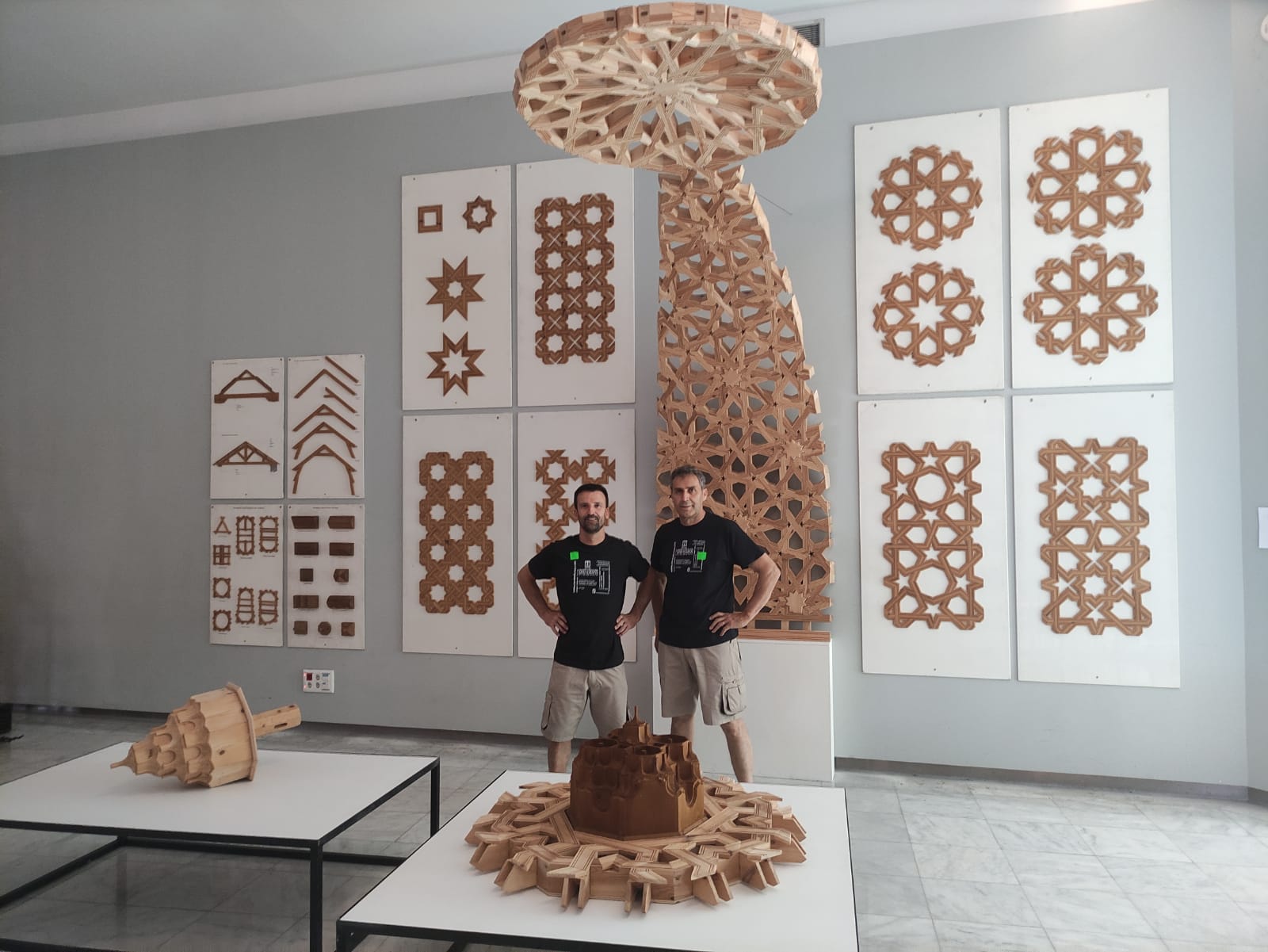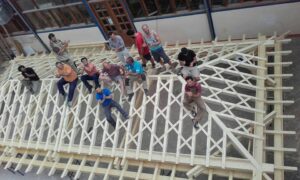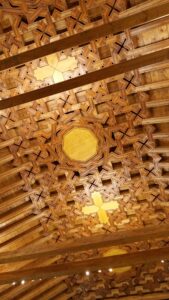
Agustín and Ricardo at Centro de los Oficios de León (Centre for the Crafts in León).
Ricardo Cambas and Agustín Castellanos are two master carpenters from the Centro de los Oficios de León (Centre for the Crafts in León), Spain. They specialise in Mudejar carpentry, very common in Spain between the 12th and 18th centuries. The aim of the crafts centre is to teach young people traditional crafts and to contribute to the restoration of cultural heritage.
Here is our interview with them about the impact of their work and how they teach this heritage craft.
1. Please introduce yourself (profession, area of expertise and years of experience).
We are 2 carpentry masters and teachers of the Centro de los Oficios de León. The trade schools in Spain were an initiative created in the 80’s, they taught traditional trades to unemployed young people. In these structures you could typically find professionals of the field and young people receiving training in heritage restoration. Our school began in 1987, following this tradition.
We have been professors of woodworking and carpentry for more than 30 years. We received the Richard H. Driehaus Building Arts Award in 2022 and obtained high recognition for the work we are doing in recovering and disseminating the Spanish carpentry tradition of “carpintería de armar” or “de lo blanco” (structural carpentry).
We have a very specific construction tradition developed in Spain from the 13th to the 18th century. These series of carpentry structures with strapwork are called “Mudejares”. There are more than 12,000 trusses of the period catalogued throughout Spain and South America.
We have been researching on this topic for 22 years, from the works of the Spanish architect and specialist of the matter, Enrique Nuere. We started by building small models and structures, but we are now building large scale structures that can afterwards be installed in buildings, usually churches, in order to restore their damaged roofs and provide them with a very rich and well elaborated ornamental structure. All this while giving training to people who want to learn how to make and restore this kind of structures: students over 18 years old, architects or even heritage lovers.

Woodwork for the ceiling of St Martin’s Church in Robledo de Losada, Spain.
2. What clients/markets do you work with (are they local, national or international)? Which needs does your work generally tackle? Which are the required skills and certifications that your customers request?
We do this “Carpinteria de armar” works punctually for clients throughout the summer during our summer classes, taking advantage of the agreements we have with associations or individuals.
We are a municipal school so our city council reaches agreements with neighbourhood councils or individuals who agree to provide us with the materials we need and in exchange we give them back the work done. Once the course is finished, they take care of the installation of the work. This way we ensure that the students who attend the course have a real work experience, in addition to the theoretical training we give them.
We work in our immediate environment, although on some occasions we have also given courses in Madrid, Valencia and even in Colombia.
3. Please briefly explain how your profession is related to religious heritage and/or cultural heritage.
Our work is related to religious heritage because we occasionally work with churches. Last year, a small town in the province of León, Valcabado del Páramo, contacted us to carry out the restoration of a truss in the central nave of their church. Our first intervention aimed to provide the entrance portico of the church with a small truss made of strap works. Then, we made a re-creation of the truss, because there were only a few remains of the original one in the presbytery. The new truss that we made during our summer course could then be installed in this church.
Moreover, in our area the dioceses have a lot of buildings and it is very difficult to maintain these buildings in good condition. Nowadays the needs for work are enormous. These buildings need urgent intervention, especially in the area of roofing. The inhabitants of the municipalities have an enormous role in the preservation of this heritage because they launch crowdfunding campaigns to finance this type of project.

Ceiling of St Martin’s Church in Robledo de Losada, Spain.
4. Please describe the main steps of your usual working process and the materials that you use most.
Our work begins with the selection of the intervention (according to the location and the needs of the work). Once the project is chosen, we make the plans and drawings that allow us to assess the price of the materials in order to generate the roof. Then we take care of preparing the woods, scheduling the classes in question, and the duration. Once the truss is built, it is moved to the site, we take care of the treatment and finally we install it ourselves or call another company to handle this task.
We work with conifers such as pine or fir. The denomination of “carpintería de lo blanco” comes from the constructive tradition in this type of wood, which are pale woods.
5. Do you regularly cooperate with craft professionals from other fields? If yes, can you explain which ones and why?
We have a direct collaboration between our school and external companies that are in charge of the remaining parts of the work that could not be carried in the timeframe of our summer classes. The workers of these companies are usually old students of the school. They are in charge of giving the appropriate treatment to the work or assembling the structures, for example.
6. Please mention any innovation that helped improve your work (technological, digital, material related, legal…) and explain the impact they had on your profession.
In the design part we are helped by graphic design programs, which allow us to have a very precise control over the drawing process.
In the workshop we also use electro portable machine tools or some more complex numerical control machines. They allow us to facilitate the work and achieve greater precision. The technology applied to this specialty of carpentry is a great help. But we must keep in mind that technology is irrelevant without the craft, the constructive logic, the know-how. Both elements are complementary.
7. What would you recommend to a young person interested in your profession? What are the opportunities and areas in which they can work with your skills?
Ricardo: I finished high school and I suddenly told my parents that I wanted to train in carpentry. I was actually a student of the first promotion of this school, in Leon. That was an upset at family level. I discovered the carpentry trade and began to realise the deep satisfaction that working with my hands brings. Learning a trade is something you spend a lifetime doing, and you never finish. It is a job that mobilises all your creativity because you start from a material that you end up transforming into a unique piece.
Agustín: I have discovered an exciting world where you can feel completely fulfilled because the creative part of designing and building brings great satisfaction. I would encourage young people to try to discover what they would like to do with their own hands or what skills they can develop because there is a lot of work to be done.
8. Which are the threats that may endanger your profession? Can you mention some difficulties that are associated with your work? Which could be the solutions to better support your profession and preserve the transmission of skills?
We are a municipal school, so the biggest threat we have is that our city council, which finances the project, stops giving us this economic support. We need the institutions to invest in the recovery of traditional trades. Cultural heritage is not only a fundamental local economic resource but also a symbol of identity.
You can find out more about Ricardo Cambas and Agustín Castellanos’ work on the website of the Spanish Network of Traditional Construction Masters as well as on Facebook.
 Mad’in Europe (MIE) is a small company committed to promoting craft professionals and crafts professions and to supporting the transmission of crafts skills at a European level. Its multilingual portal gathers a large audience around the profiles of 1,500 crafts, restorers and fine crafts professionals. As a member of some European organizations and thanks to its wide European network MIE participates in several transversal activities including Erasmus and Horizon projects which focus on valorisation of crafts, preservation of traditional know-how, and raising awareness among young people, for whom the sector represents a source of employment.
Mad’in Europe (MIE) is a small company committed to promoting craft professionals and crafts professions and to supporting the transmission of crafts skills at a European level. Its multilingual portal gathers a large audience around the profiles of 1,500 crafts, restorers and fine crafts professionals. As a member of some European organizations and thanks to its wide European network MIE participates in several transversal activities including Erasmus and Horizon projects which focus on valorisation of crafts, preservation of traditional know-how, and raising awareness among young people, for whom the sector represents a source of employment.
 Future for Religious Heritage (FRH) is an independent, non-faith, non-profit European network founded in 2011 and based in Brussels to promote, encourage and support the safeguard, maintenance, conservation, restoration, accessibility and embellishment of historic places of worship. Our network represents more than 80 organisations and over 120 professionals from 36 countries, which includes NGOs, governmental organisations, religious and university departments, and individuals. We are one of the 36 European networks currently supported by the Creative Europe Networks programme.
Future for Religious Heritage (FRH) is an independent, non-faith, non-profit European network founded in 2011 and based in Brussels to promote, encourage and support the safeguard, maintenance, conservation, restoration, accessibility and embellishment of historic places of worship. Our network represents more than 80 organisations and over 120 professionals from 36 countries, which includes NGOs, governmental organisations, religious and university departments, and individuals. We are one of the 36 European networks currently supported by the Creative Europe Networks programme.





Follow us: